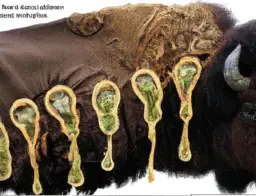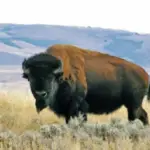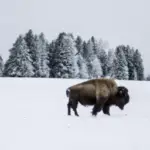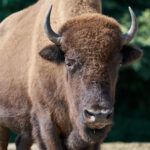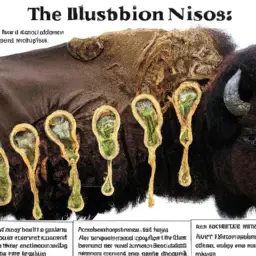
Understanding Bisons: An Overview
Bisons, also known as American bison or buffalo, are majestic creatures that have captured the imagination of people for centuries. In this article, we will explore the various aspects of bison biology, focusing in particular on their unique digestive system. From their habitat and physical characteristics to their role in the food chain and conservation status, we will delve into the fascinating world of bison and their interaction with the environment.
Bison species
There are two main species of bison: the American bison (Bison bison) and the European bison (Bison bonasus). The American bison is native to North America and is the largest land mammal in the region. It has a distinct hump on its shoulders and a shaggy coat that provides insulation during harsh winters. The European bison, on the other hand, is found in forests and grasslands of Eastern Europe and is slightly smaller than its American counterpart.
Habitat and geographical spread
Historically, bison roamed across vast expanses of North America, from the Great Plains to the Rocky Mountains. They were an integral part of the ecosystem, shaping the landscape through their grazing behaviors. However, due to habitat loss and overhunting, their range has significantly decreased, and they are now primarily found in national parks and conservation areas.
Physical characteristics
Bisons are characterized by their large, robust bodies and long, curved horns. They have a shoulder hump, which is formed by muscles that help them powerfully thrust their heads forward during foraging. Their shaggy coat offers protection against extreme weather conditions, such as snowstorms and intense heat. Bisons can reach heights of up to six feet at the shoulder and can weigh over a ton, making them an impressive sight to behold.
Bisons in the Food Chain
As herbivores, bisons play a vital role in the food chain. They primarily feed on grasses, sedges, and other vegetation, relying on their unique digestive system to extract nutrients from these fibrous plant materials. By consuming large quantities of vegetation, bison contribute to the balance of ecosystems by controlling plant growth and providing food for predators such as wolves and bears.
Conservation status
The conservation status of bison has improved in recent years, thanks to dedicated efforts by conservation organizations and national parks. The American bison, which was once on the brink of extinction, has made a remarkable recovery and is now classified as “near threatened” by the International Union for Conservation of Nature (IUCN). However, the European bison still faces challenges, and conservation efforts continue to ensure its survival.
Human interaction
Throughout history, bison have played a significant role in the lives of indigenous peoples of North America. They were a source of food, clothing, and shelter, and their hides were used for various purposes. However, the arrival of European settlers led to a dramatic decline in bison populations, driven by overhunting and habitat loss. Today, bison are valued for their ecological importance and are a symbol of conservation and restoration efforts.
The Bison Digestive System
Anatomical Overview
To understand the bison’s digestive system, we must first examine its anatomy. Like other ruminants, bison possess a complex, four-stomach digestive system that enables them to efficiently digest plant-based food. The four compartments of their stomach are the rumen, reticulum, omasum, and abomasum. Each stomach has a specific role in the digestion process, working together to extract nutrients from fibrous plant material.
Special Adaptations
The bison’s digestive system has evolved unique adaptations to overcome the challenges of breaking down and extracting nutrients from tough plant matter. One key adaptation is the presence of microorganisms in the first stomach, the rumen. These microorganisms, including bacteria and protozoa, help to ferment and break down the cellulose present in plant cell walls, making the nutrients more accessible for absorption.
Importance of Digestive System
The bison’s digestive system is crucial for its survival and plays a significant role in its ability to thrive in its natural habitat. By efficiently extracting nutrients from tough plant materials, bison can fulfill their energy and nutrient requirements, enabling them to sustain their large bodies and survive in harsh environments where other herbivores may struggle to find adequate nutrition.
Efficiency of Digestion in Bisons
The bison’s digestive system is remarkably efficient at extracting nutrients from plant material. This efficiency is due to the fermentation process that occurs in the first stomach, the rumen. The microorganisms present in the rumen break down cellulose, a complex carbohydrate that is indigestible to most mammals, into simpler compounds that can be absorbed by the bison’s body.
Bison’s Feeding Habits
Bisons are grazers, meaning they primarily consume grasses and other low-lying vegetation. They have a unique feeding habit known as “selective grazing,” where they carefully select certain plant species over others. This selective grazing behavior helps maintain a diverse plant community and prevents the dominance of any particular species. By consuming a variety of plant species, bison contribute to the overall health of the ecosystem.
Four-Stomach Digestion: The Ruminant Process
Definition of Ruminant
Ruminants are a group of mammals that have a specialized four-stomach digestive system. This group includes animals such as cows, sheep, and goats, as well as bison. The term “ruminant” refers to the process of regurgitating and re-chewing partially digested food, known as “rumination,” which is a distinctive characteristic of these animals.
Advantages of Being Ruminant
The ruminant digestive system provides several advantages to animals like bison. Firstly, it allows for the efficient breakdown of tough plant materials, such as cellulose, which cannot be digested by most mammals. Secondly, it enables ruminants to obtain essential nutrients from a high-fiber diet, which is abundant in grasses and other plant material. Lastly, the fermentation process in the rumen produces essential nutrients, such as volatile fatty acids, which serve as an additional energy source for the ruminant.
The Process of Rumination
Rumination is a crucial process in the ruminant digestive system that enhances the digestion of plant material. After the initial ingestion of food, it passes through the first three stomachs without much further breakdown. The partially digested food, also known as “cud,” is then regurgitated and re-chewed, breaking it down further into smaller particles. This allows for more effective microbial fermentation and increases the surface area of the food for improved nutrient extraction.
Common Misconceptions
There are often misconceptions about the number of stomachs that ruminants, including bison, possess. While they indeed have four compartments in their digestive system, these are anatomically classified as stomachs. However, functionally speaking, each compartment serves a unique purpose and plays a specific role in the overall digestive process. It is important to understand that the four stomachs work together as a system rather than operating independently.
The First Stomach: The Rumen
Size and Structure of the Rumen
The rumen, the first and largest stomach in the bison’s digestive system, is a fermentation chamber responsible for breaking down fibrous plant material. It can hold up to 50 gallons of content and has a unique structure that facilitates fermentation. The rumen is lined with finger-like projections called papillae, which increase the surface area for microbial attachment and nutrient absorption.
Function of Rumen
The rumen’s main function is to provide an environment conducive to the breakdown of cellulose through the fermentation process. It houses billions of microorganisms, including bacteria, protozoa, and fungi, which work together to ferment plant material and break it down into simpler compounds that can be digested by the bison. The fermentation process produces volatile fatty acids, which are a significant energy source for the bison.
Microorganisms in the Rumen
The rumen is a complex ecosystem hosting a diverse community of microorganisms. Bacteria, protozoa, and fungi work synergistically to break down plant fibers into simpler compounds. Bacteria are responsible for cellulose degradation, protozoa assist in breaking down complex carbohydrates, and fungi contribute to lignin degradation. This microbial community has evolved in a symbiotic relationship with the bison, providing them with the ability to digest and extract nutrients from tough plant materials.
Role of Rumen in Digestion
The rumen plays a crucial role in the bison’s digestion process. It acts as a fermentation chamber, where fibrous plant material is broken down and converted into simpler, digestible compounds. The microorganisms present in the rumen produce enzymes that break down cellulose, hemicellulose, and other complex carbohydrates. The breakdown of these compounds releases essential nutrients, such as proteins and volatile fatty acids, which can be absorbed by the bison’s body.
The Second Stomach: The Reticulum
Physical Characteristics of the Reticulum
The reticulum, also known as the “honeycomb,” is the second stomach of the bison’s digestive system. It is a smaller compartment located just below the rumen. The reticulum derives its name from its characteristic honeycomb-like structure, formed by muscular ridges or folds. These folds allow for further breakdown of food particles and assist in the separation of heavy and coarse materials from the finer particles.
Function of the Reticulum
The primary function of the reticulum is to assist in the mechanical breakdown of partially digested food and the separation of large food particles from smaller particles. It contracts and relaxes, creating an environment where further mixing and separation can occur. The reticulum also acts as a filter, preventing large or foreign objects from reaching the other compartments of the digestive system.
Reticulum and Rumen: The Connection
The reticulum and the rumen are anatomically and functionally connected, working together to ensure efficient digestion of plant material. After food is partially fermented and broken down in the rumen, it moves into the reticulum for further processing. The reticulum helps separate larger food particles and directs them back to the rumen for additional fermentation, while finer particles continue their journey through the digestive system.
The Third Stomach: The Omasum
Characteristics of the Omasum
The omasum, also known as the “manyplies,” is the third stomach of the bison’s digestive system. It is a smaller compartment located between the reticulum and the abomasum. The omasum has a unique structure consisting of numerous layers of muscular, leaf-shaped tissue. These layers increase the surface area and provide a means for better absorption of water and nutrient processing.
Role in Absorption
The primary role of the omasum is to further remove moisture from the partially digested food and absorb water and electrolytes. The multiple layers and folding of the omasum tissue allow for a slower passage of food particles, providing more time for absorption. Any remaining nutrients, such as volatile fatty acids and water-soluble vitamins, are also absorbed in this compartment before moving on to the final stomach, the abomasum.
The transition from Reticulum to Omasum
After passing through the reticulum, the partially digested food enters the omasum. In the omasum, water is extracted from the food, and further absorption of nutrients takes place. The omasum plays a critical role in ensuring the efficient utilization of nutrients from the bison’s diet, preparing them for the final stage of digestion in the abomasum.
The Fourth Stomach: The Abomasum
Recognizing the Abomasum
The abomasum, often referred to as the “true stomach,” is the fourth and final stomach of the bison’s digestive system. It is the equivalent of the stomach found in non-ruminant animals, such as humans and other carnivores. The abomasum is located after the omasum and plays a crucial role in the final stages of digestion and nutrient absorption.
Purpose of the Abomasum in Digestion
The main function of the abomasum is to secrete enzymes and acids, similar to the stomachs found in non-ruminant animals. These enzymes and acids help to break down proteins, fats, and carbohydrates into simpler compounds, facilitating their absorption in the small intestine. The abomasum is responsible for the final breakdown of food before it is passed onto the small intestine for further processing and nutrient absorption.
From Omasum to Abomasum: The Journey
After leaving the omasum, the partially digested food enters the abomasum. In the abomasum, the food is exposed to the acidic environment created by stomach acids, which aids in the breakdown of proteins and other compounds. This process further prepares the nutrients for absorption in the small intestine, where they will be absorbed into the bloodstream and transported to various parts of the bison’s body.
Bison Stomachs and Bison Nutrition
Diet of Bison
Bisons are herbivores, with their diet consisting primarily of grasses and other low-lying vegetation. They are extremely selective grazers, carefully choosing the most nutritious plant species over others. Their ability to digest fibrous plant materials efficiently, coupled with their grazing behavior, allows them to obtain the necessary nutrients for their survival.
The Role of Each Stomach in Processing Food
Each stomach in the bison’s digestive system plays a crucial role in processing food and extracting nutrients. The rumen breaks down cellulose through fermentation and produces volatile fatty acids, which serve as an energy source for the bison. The reticulum aids in the mechanical breakdown of food and separates large particles from smaller ones. The omasum further removes moisture and absorbs water and electrolytes. Finally, the abomasum secretes enzymes and acids to break down proteins, fats, and carbohydrates for absorption in the small intestine.
Nutrient Extraction: A Four-stomach Advantage
The four-stomach digestive system of bison provides them with a distinct advantage in nutrient extraction from their herbivorous diet. By fermenting and breaking down cellulose in the rumen, bison can access the energy-rich compounds contained within plant cell walls. This allows them to extract nutrients from fibrous plant materials that would otherwise be indigestible for most mammals, enabling them to thrive in their natural habitat.
Bison Stomachs Compared to Other Ruminants
Similarities with Cows and Deer
Bison, cows, and deer are all members of the ruminant family, sharing similarities in their digestive systems. They all possess a four-stomach system and rely on microbial fermentation to break down plant material. Additionally, they exhibit selective grazing behavior, carefully choosing certain plant species over others. These commonalities highlight the shared evolutionary adaptations among these animals, enabling them to efficiently utilize plant-based diets.
Differences from Other Ruminants
While bison share similarities with other ruminants, they also have distinct differences in their physiology and grazing behaviors. Bisons, for example, are better adapted to graze on tougher and coarser grasses compared to cows, which prefer softer and more easily digestible plant species. Additionally, bison tend to graze over larger areas, exhibiting a more nomadic behavior compared to cows, which typically have more sedentary grazing patterns.
Evolutionary Adaptations of Bison Stomachs
The unique adaptations in the bison’s stomachs have evolved over time to suit their particular dietary needs and survival in their natural habitat. The ability to efficiently digest tough plant materials through fermentation and the selective grazing behavior have allowed bison to successfully thrive in grassland environments. These adaptations reflect the evolutionary processes that have shaped the bison into the magnificent creatures we observe today.
Why Does the Number of Stomachs a Bison Has Relate to the Population of Wood Bison?
The wood bison population status revealed sheds light on the intriguing relationship between the number of stomachs a bison has and their population. These majestic creatures possess a complex digestive system comprising four stomach chambers. This allows them to efficiently process tough vegetation, contributing to their ability to thrive in their natural habitat. By understanding the wood bison population status, researchers can gain insights into their overall health and adaptability to various environmental conditions.
Impacts of Bison Stomachs: Environment and Ecosystem
Bison Grazing and Land Management
Bison grazing plays a crucial role in shaping the landscape and maintaining the health of the ecosystem in which they reside. By consuming grasses and other vegetation, bison help control plant growth and prevent the dominance of any particular plant species. Their selective grazing behavior also contributes to the maintenance of a diverse plant community, which is essential for the stability and resilience of the ecosystem.
Stomach Health and Bison Population
The health of the bison’s stomachs directly impacts their overall well-being and population dynamics. Any disruption or imbalance in the microbial ecosystem within their stomachs can lead to digestive issues and nutritional deficiencies. These issues can negatively impact the bison’s ability to extract nutrients and maintain a healthy population. Therefore, conservation efforts must focus on preserving the integrity and health of the bison’s unique digestive system.
Contribution to Biodiversity and Ecosystem Balance
Bisons, with their specialized digestive system, contribute to the overall biodiversity and balance of the ecosystems they inhabit. Their grazing behaviors and selective grazing help control plant species composition and create a mosaic of habitats, benefiting a wide range of other wildlife. Additionally, the nutrient cycling facilitated by their digestion supports the growth and regeneration of vegetation, leading to a healthier and more diverse ecosystem.
In conclusion, bison are remarkable creatures with a unique digestive system that allows them to efficiently extract nutrients from fibrous plant material. Their four-stomach digestive system, comprising the rumen, reticulum, omasum, and abomasum, provides them with the ability to break down tough plant materials and obtain essential nutrients. By understanding and appreciating the bison’s digestive system and its role in their survival, we can better appreciate these majestic animals and their importance in maintaining healthy and balanced ecosystems.

